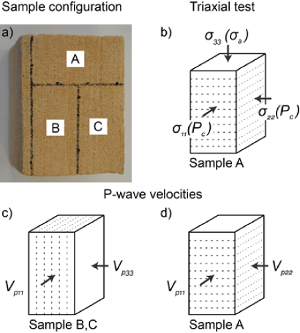| |||||||
|
|
|||||||
|
|
|||||||
| P-wave Anisotropy | |||||||
|
In this Knowledgebase, we described and analyzed numerous structural concepts that are intimately related to certain properties of undeformed rocks. For example, porosity and permeability of structures are only meaningful with respect to the porosity and permeability of the host rocks in which they occur. In some cases, it is convenient to provide these host rock properties under the relevant structure types. One of these types of petrophysical properties, P-wave velocity, is related to rock fracturing and fractured rock and plays an important role in the formation, orientation, and pattern of joints and deformation bands is the Jurassic Aztec Sandstone cropping out in broad areas in southeastern Nevada and western Utah. Figure 1(a) is a view of Aztec Sandstone in Valley of Fire State Park showing its informal units labelled as Lower, Transition, and Upper. The petrophysical properties of these units are remarkably different (Flodin et al., 2003) and play important roles in the type and distribution of the structures in these units. The plot in Figure 1(b) shows representative porosity with the Lower unit having the lowest porosity values and the Upper units having the highest porosity values. The transition unit between the Lower and Upper parts in which deformation bands occur most abundantly has porosity values in between those of the Lower and Upper parts. The plot in Figure 1(c) shows P-wave velocities measured from the same units and the trend is consistent with that of the porosity, that is, inversely proportional. The P-wave velocities measured recently in the laboratory by Deng et al. (2015) were motivated with a hypothesis of the presence of a P-wave anisotropy with respect to cross-bedding. The configurations of the samples used in the laboratory tests are illustrated in Figure 2. The plots in Figure 3 of the measured P-wave velocities in bed-parallel (11) and bed-perpendicular (33) directions (Figure 3(a)) show an average of 13% anisotropy. However, the velocities in two orthogonal directions along the bedding (Figure 3(b)) are not significantly different.
The significance of this transverse anisotropy will be discussed under 'Compaction Bands' and 'Joints.' | |||||||
| Reference: |
|||||||
| Deng, S., Cilona, A., Morrow, C., Mapeli, C., Liu, C., Lockner, D., Prasad, M., Aydin, A., 2015 Flodin, E.A., Prasad, M., Aydin, A., 2003 |
|||||||
|
Readme | About Us | Acknowledgement | How to Cite | Terms of Use | Ⓒ Rock Fracture Knowledgebase |
|||||||


